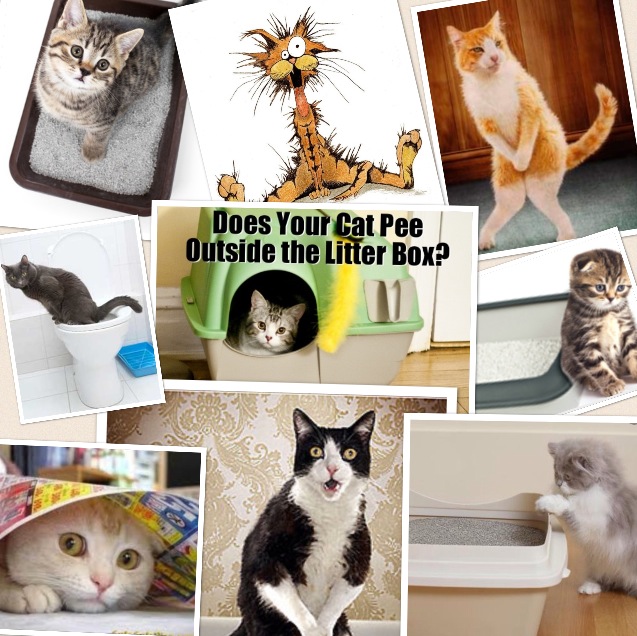
Why Doesn’t My Cat Use The Litter Box?
As a veterinarian, cats not urinating in their litter box is one of the most frustrating problems I see (second to allergies and skin disease), but more for my clients and their cats. I see this often, unfortunately, and it can be caused by many things, ranging from illness to behavior and stress. According to the research, at least 10% of cats will develop elimination problems, but I am going to go out on a limb here and say IT’S WAY MORE THAN THAT! So what causes this problem, and what can I do to help?
Why doesn’t my cat use the litter box?
First and foremost, your veterinarian MUST rule out disease of the urinary system (which involves the kidneys, the ureter, the bladder, the urethra, the vagina, and the penis). Once all medical problems that can be causing your cat to inappropriately urinate all over your bed, or your shoes, or your favorite couch are ruled out, then you can back into a diagnosis of stress and behavior. I hate when I have to tell my clients that stress and behavior is my diagnosis because its the most difficult problem to deal with and overcome.
What medical issues can be causing my cat to not use their litter box?
Medical Diseases:
- Urinary Tract Infection (UTI)
- Feline Interstitial Cystitis
- Kidney or Bladder Stones or Blockage
- Cancer of the Urinary System
- Genetic Anatomical malformation of the urinary tract
- Systemic illness
Your veterinarian will want to perform full bloodwork with a urinalysis, radiographs, and possibly more advanced diagnostic studies such as an ultrasound and/laparscope to rule out any of these diseases and treat accordingly. If and when all these medical diseases have been ruled out with proper diagnostic testing, then we back into a diagnosis of stress and behavior. And this is when it gets hard.
What are the different stresses and behavior problems and how can I alleviate and help the circumstances?
- Urine Marking
- Litter-Box Management Problems
- Surface Preference
- Litter Preference or Aversion
- Location Preference or Aversion
- Inability to Use the Litter Box
- Negative Litter-Box Association
- Household stress
- Multi-Cat Household Conflict
My veterinarian diagnosed my cat with stress and behavior inappropriate elimination. What can I do to to help my cat?
- Clean the litter box at least once a day and rinse it out completely with baking soda or unscented soap once a week. The problem with scented cleaners is that your cat could develop an aversion to the scent.
- Make sure the litter box is LARGE and EASILY ACCESSIBLE.
- Provide one to two inches of litter rather than three to four inches.
- Use clumping, unscented litter.
- Try and use the same litter they used as a kitten.
- Never change the litter that your cat uses regularly.
- Eliminate the box liners or lids.
- Cats like their litter boxes located in a quiet isolated location (avoid areas near the washer and dryer or next to your dog’s food and water bowls or areas where there’s a lot of foot traffic).
- Because self-cleaning boxes are generally cleaner than traditional types of litter boxes, many cats accept them readily. However, if you’re using a self-cleaning litter box and your cat starts eliminating outside the box, try switching to a traditional type of litter box.
- Provide more than 1 litter boxes. The general guideline is one for each cat in your household, plus one extra.
- Put your cat’s food bowls somewhere other than right next to her litter box.
- Clean accidents thoroughly with an enzymatic cleanser designed to neutralize pet odors.
- If your cat soils in just a few spots, place litter boxes there. If that is not possible, place their food bowl, water bowl, bed or toys in that area to discourage further elimination.
- Make inappropriate elimination areas less appealing by using motion-activated lights in dark areas, or placing upside-down carpet runners, tin foil or double-sided sticky tape in the area where your cat has eliminated in the past.
- Switch to a litter box with low sides for special-needs cats such as those who are older, arthritic or still very young.
For cats that are responding to household stress:
- Keep their food bowls full and in the same place.
- Keep their routine as predictable as possible.
- Prevent the dog, if you have one, from chasing them.
- Close blinds, windows, and doors so they are not upset by cats outside.
- Create vertical resting spots on shelves or window sills or multi-perch cat trees for homes with multi-cats.
- In multi-cat households try and distribute individual resources such as food, water, cat posts or trees, and litter boxes so that each cat can make use of them without coming into contact with one of the other cats.
- If you can’t eliminate sources of stress, try to reduce them.
- Feliway spray or diffusers deliver a synthetic pheromone that has been shown to have some effect in relieving stress in cats.
- Medications- always consult with your veterinarian or a veterinary behaviorist before giving your cat any type of medication for a behavior problem.
- For cats that have developed a negative litter box association– move your cat’s litter box to a new location, and add a few litter boxes in different locations at the same time. Pick areas where your cat can see who is approaching from any sides that are not cornered. These locations should also have multiple escape routes so that your cat can quickly leave her litter box if she suddenly feels anxious. Try and pick a spot where children and other animals do not have access. Fill the litter boxes 1 to 2 inches deep with a litter that is a little different from the litter in the boxes your cat avoids. Try and make the litter box a positive place for your cat and play with them near the box, treats, and toys. If you have a long-haired cat, have the hair on the hind end clipped if you notice that it gets soiled or matted during elimination. Matting can cause the hair to get pulled when the cat eliminates which can be painful for the cat and make her skittish of her litter box.
Inappropriate elimination with cats is an extremely frustrating problem and multifactorial, making it even more challenging to treat. Unfortunately, it is the number one reason why people euthanize or relinquish their pets to the shelter. There are many things that can be done to try and alleviate the behavior and the underlying stress associated with it. With some hard work, dedication, and consistency, I see great responses to treatment. Please speak with your veterinarian and see if you can come up with a plan for your cat. I hope this article was helpful. Have a great weekend, and see you next week!




